Data Analysis: Qualitative and Quantitative Approaches in Leadership
VerifiedAdded on 2020/04/15
|17
|4112
|121
Report
AI Summary
This report presents a comparative analysis of qualitative and quantitative research studies in the context of leadership. The qualitative study examines team leadership across different contexts, exploring leadership functions within multidisciplinary teams and IT companies through semi-structured interviews. Findings reveal variations in leadership functions based on team context, highlighting the importance of performance criteria and transition/action phase functions. The quantitative study assesses a Senge learning organization (LO) intervention, using employee surveys to measure job satisfaction over five years. Results indicate enhanced job satisfaction in the intervention group, demonstrating a positive correlation. The report discusses the credibility of the research, provides a literature review, theoretical framework, hypotheses, research approach, design, methodology, population, ethical implications, data collection, reliability, validity, and data analysis methods. It concludes with implications for team leadership and the application of Senge's disciplines in organizational development. The report emphasizes the importance of context-specific leadership functions and the potential of Senge's LO intervention to improve employee satisfaction.
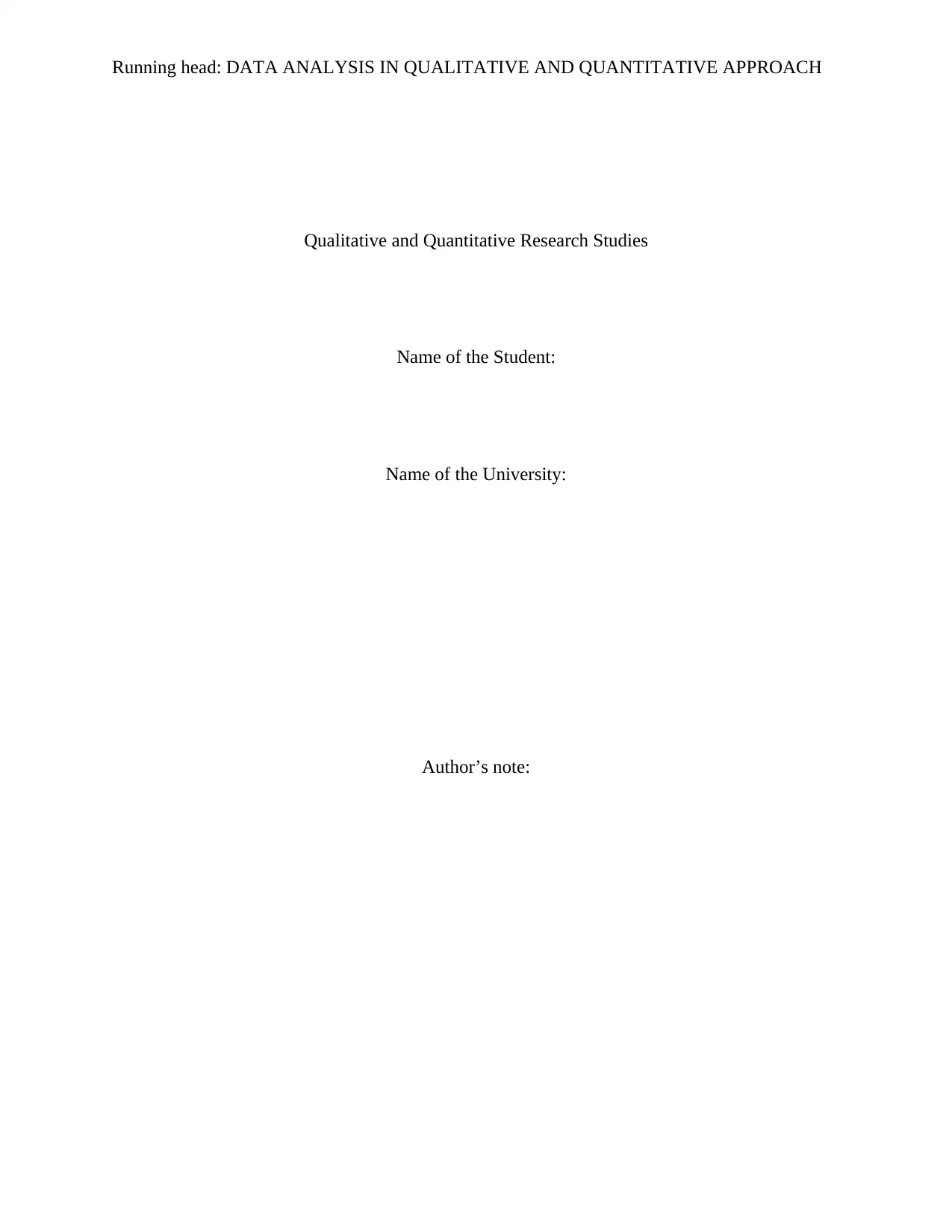
Running head: DATA ANALYSIS IN QUALITATIVE AND QUANTITATIVE APPROACH
Qualitative and Quantitative Research Studies
Name of the Student:
Name of the University:
Author’s note:
Qualitative and Quantitative Research Studies
Name of the Student:
Name of the University:
Author’s note:
Paraphrase This Document
Need a fresh take? Get an instant paraphrase of this document with our AI Paraphraser
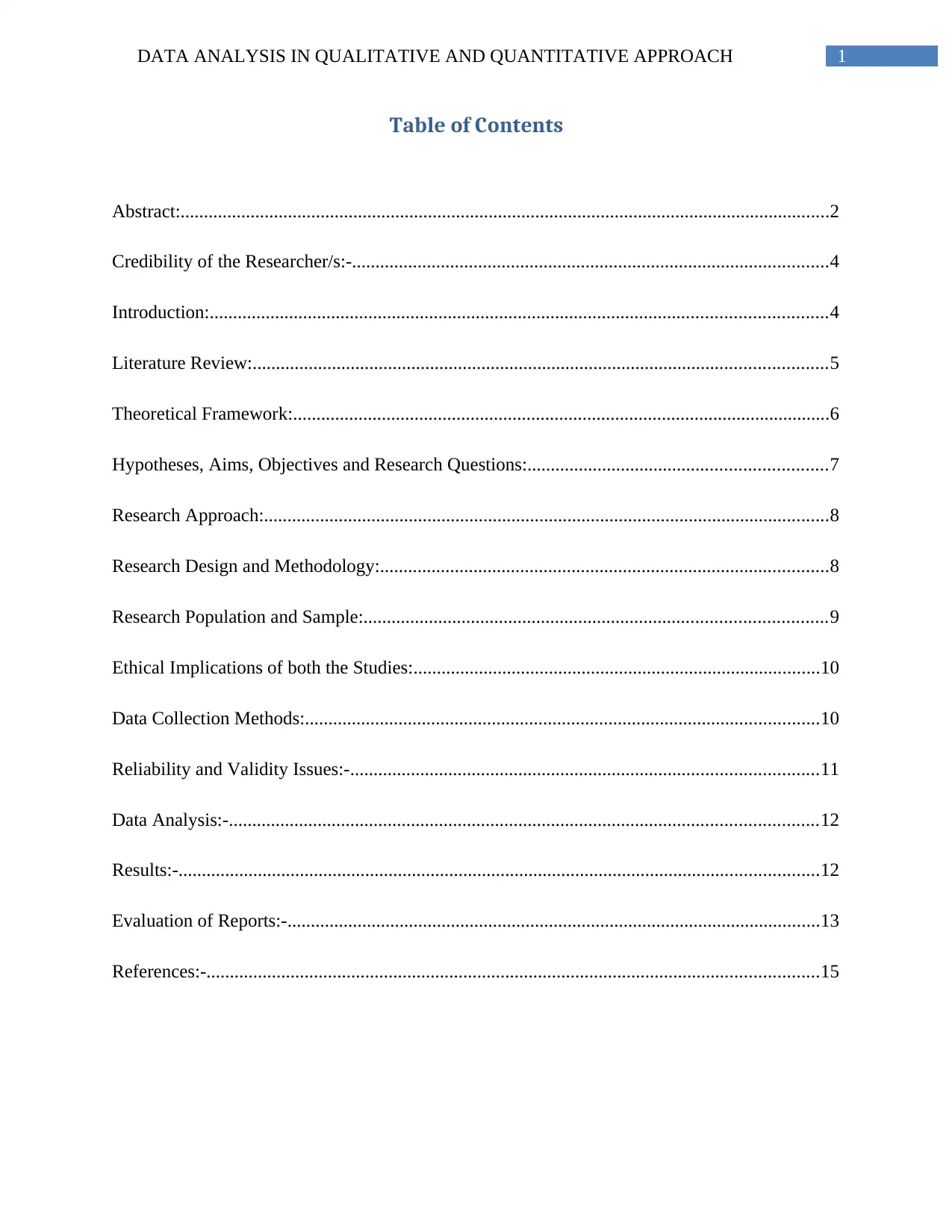
1DATA ANALYSIS IN QUALITATIVE AND QUANTITATIVE APPROACH
Table of Contents
Abstract:...........................................................................................................................................2
Credibility of the Researcher/s:-......................................................................................................4
Introduction:....................................................................................................................................4
Literature Review:...........................................................................................................................5
Theoretical Framework:...................................................................................................................6
Hypotheses, Aims, Objectives and Research Questions:................................................................7
Research Approach:.........................................................................................................................8
Research Design and Methodology:................................................................................................8
Research Population and Sample:...................................................................................................9
Ethical Implications of both the Studies:.......................................................................................10
Data Collection Methods:..............................................................................................................10
Reliability and Validity Issues:-....................................................................................................11
Data Analysis:-..............................................................................................................................12
Results:-.........................................................................................................................................12
Evaluation of Reports:-..................................................................................................................13
References:-...................................................................................................................................15
Table of Contents
Abstract:...........................................................................................................................................2
Credibility of the Researcher/s:-......................................................................................................4
Introduction:....................................................................................................................................4
Literature Review:...........................................................................................................................5
Theoretical Framework:...................................................................................................................6
Hypotheses, Aims, Objectives and Research Questions:................................................................7
Research Approach:.........................................................................................................................8
Research Design and Methodology:................................................................................................8
Research Population and Sample:...................................................................................................9
Ethical Implications of both the Studies:.......................................................................................10
Data Collection Methods:..............................................................................................................10
Reliability and Validity Issues:-....................................................................................................11
Data Analysis:-..............................................................................................................................12
Results:-.........................................................................................................................................12
Evaluation of Reports:-..................................................................................................................13
References:-...................................................................................................................................15
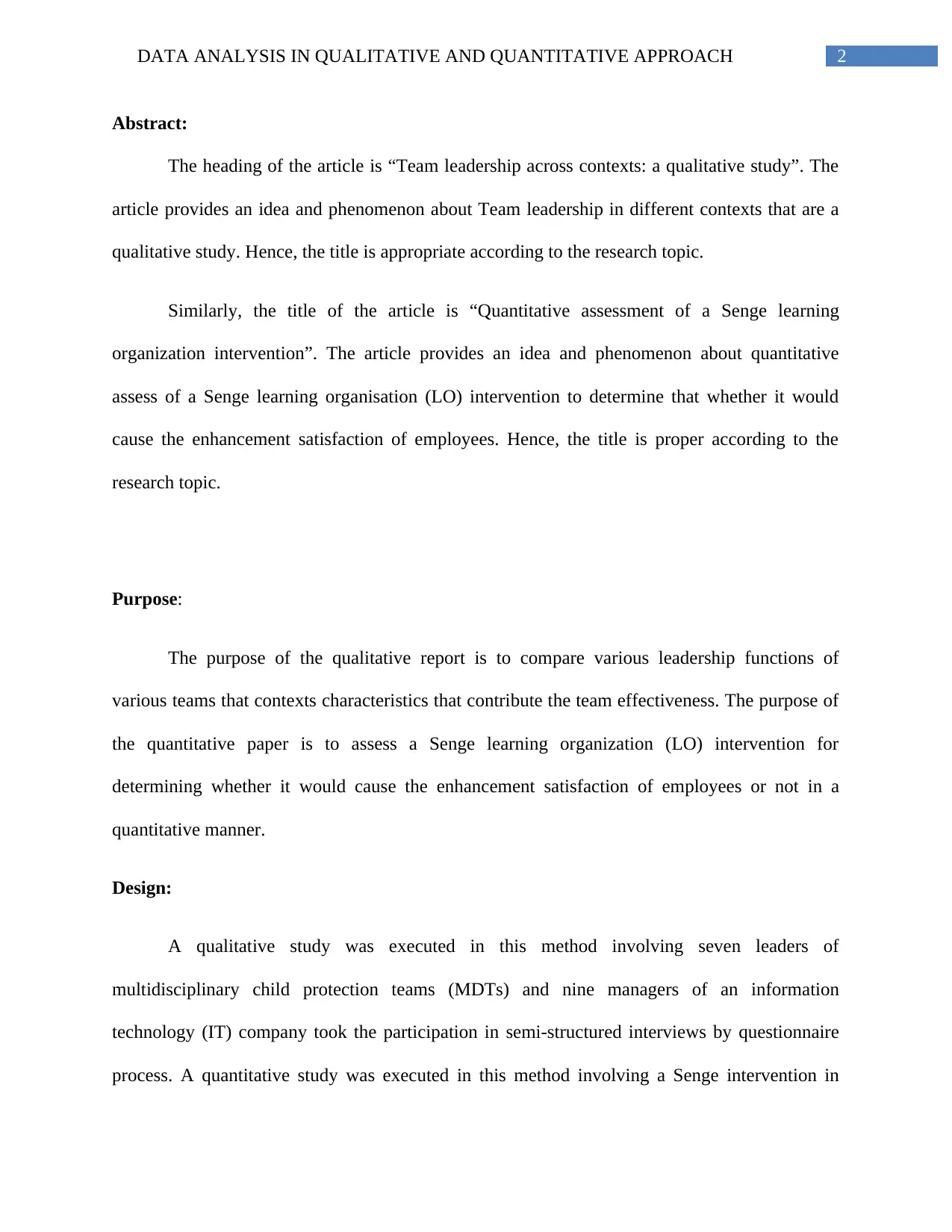
2DATA ANALYSIS IN QUALITATIVE AND QUANTITATIVE APPROACH
Abstract:
The heading of the article is “Team leadership across contexts: a qualitative study”. The
article provides an idea and phenomenon about Team leadership in different contexts that are a
qualitative study. Hence, the title is appropriate according to the research topic.
Similarly, the title of the article is “Quantitative assessment of a Senge learning
organization intervention”. The article provides an idea and phenomenon about quantitative
assess of a Senge learning organisation (LO) intervention to determine that whether it would
cause the enhancement satisfaction of employees. Hence, the title is proper according to the
research topic.
Purpose:
The purpose of the qualitative report is to compare various leadership functions of
various teams that contexts characteristics that contribute the team effectiveness. The purpose of
the quantitative paper is to assess a Senge learning organization (LO) intervention for
determining whether it would cause the enhancement satisfaction of employees or not in a
quantitative manner.
Design:
A qualitative study was executed in this method involving seven leaders of
multidisciplinary child protection teams (MDTs) and nine managers of an information
technology (IT) company took the participation in semi-structured interviews by questionnaire
process. A quantitative study was executed in this method involving a Senge intervention in
Abstract:
The heading of the article is “Team leadership across contexts: a qualitative study”. The
article provides an idea and phenomenon about Team leadership in different contexts that are a
qualitative study. Hence, the title is appropriate according to the research topic.
Similarly, the title of the article is “Quantitative assessment of a Senge learning
organization intervention”. The article provides an idea and phenomenon about quantitative
assess of a Senge learning organisation (LO) intervention to determine that whether it would
cause the enhancement satisfaction of employees. Hence, the title is proper according to the
research topic.
Purpose:
The purpose of the qualitative report is to compare various leadership functions of
various teams that contexts characteristics that contribute the team effectiveness. The purpose of
the quantitative paper is to assess a Senge learning organization (LO) intervention for
determining whether it would cause the enhancement satisfaction of employees or not in a
quantitative manner.
Design:
A qualitative study was executed in this method involving seven leaders of
multidisciplinary child protection teams (MDTs) and nine managers of an information
technology (IT) company took the participation in semi-structured interviews by questionnaire
process. A quantitative study was executed in this method involving a Senge intervention in
⊘ This is a preview!⊘
Do you want full access?
Subscribe today to unlock all pages.

Trusted by 1+ million students worldwide
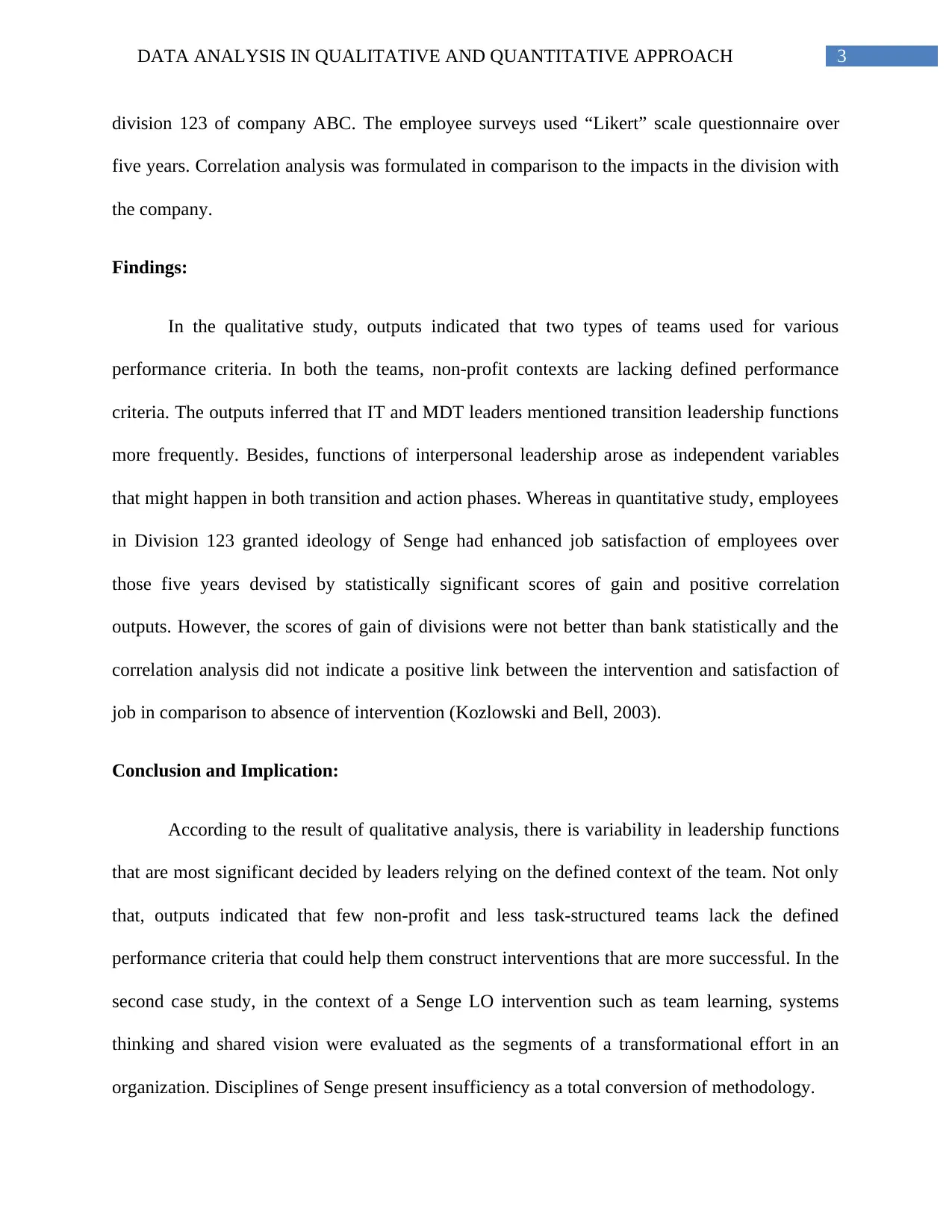
3DATA ANALYSIS IN QUALITATIVE AND QUANTITATIVE APPROACH
division 123 of company ABC. The employee surveys used “Likert” scale questionnaire over
five years. Correlation analysis was formulated in comparison to the impacts in the division with
the company.
Findings:
In the qualitative study, outputs indicated that two types of teams used for various
performance criteria. In both the teams, non-profit contexts are lacking defined performance
criteria. The outputs inferred that IT and MDT leaders mentioned transition leadership functions
more frequently. Besides, functions of interpersonal leadership arose as independent variables
that might happen in both transition and action phases. Whereas in quantitative study, employees
in Division 123 granted ideology of Senge had enhanced job satisfaction of employees over
those five years devised by statistically significant scores of gain and positive correlation
outputs. However, the scores of gain of divisions were not better than bank statistically and the
correlation analysis did not indicate a positive link between the intervention and satisfaction of
job in comparison to absence of intervention (Kozlowski and Bell, 2003).
Conclusion and Implication:
According to the result of qualitative analysis, there is variability in leadership functions
that are most significant decided by leaders relying on the defined context of the team. Not only
that, outputs indicated that few non-profit and less task-structured teams lack the defined
performance criteria that could help them construct interventions that are more successful. In the
second case study, in the context of a Senge LO intervention such as team learning, systems
thinking and shared vision were evaluated as the segments of a transformational effort in an
organization. Disciplines of Senge present insufficiency as a total conversion of methodology.
division 123 of company ABC. The employee surveys used “Likert” scale questionnaire over
five years. Correlation analysis was formulated in comparison to the impacts in the division with
the company.
Findings:
In the qualitative study, outputs indicated that two types of teams used for various
performance criteria. In both the teams, non-profit contexts are lacking defined performance
criteria. The outputs inferred that IT and MDT leaders mentioned transition leadership functions
more frequently. Besides, functions of interpersonal leadership arose as independent variables
that might happen in both transition and action phases. Whereas in quantitative study, employees
in Division 123 granted ideology of Senge had enhanced job satisfaction of employees over
those five years devised by statistically significant scores of gain and positive correlation
outputs. However, the scores of gain of divisions were not better than bank statistically and the
correlation analysis did not indicate a positive link between the intervention and satisfaction of
job in comparison to absence of intervention (Kozlowski and Bell, 2003).
Conclusion and Implication:
According to the result of qualitative analysis, there is variability in leadership functions
that are most significant decided by leaders relying on the defined context of the team. Not only
that, outputs indicated that few non-profit and less task-structured teams lack the defined
performance criteria that could help them construct interventions that are more successful. In the
second case study, in the context of a Senge LO intervention such as team learning, systems
thinking and shared vision were evaluated as the segments of a transformational effort in an
organization. Disciplines of Senge present insufficiency as a total conversion of methodology.
Paraphrase This Document
Need a fresh take? Get an instant paraphrase of this document with our AI Paraphraser
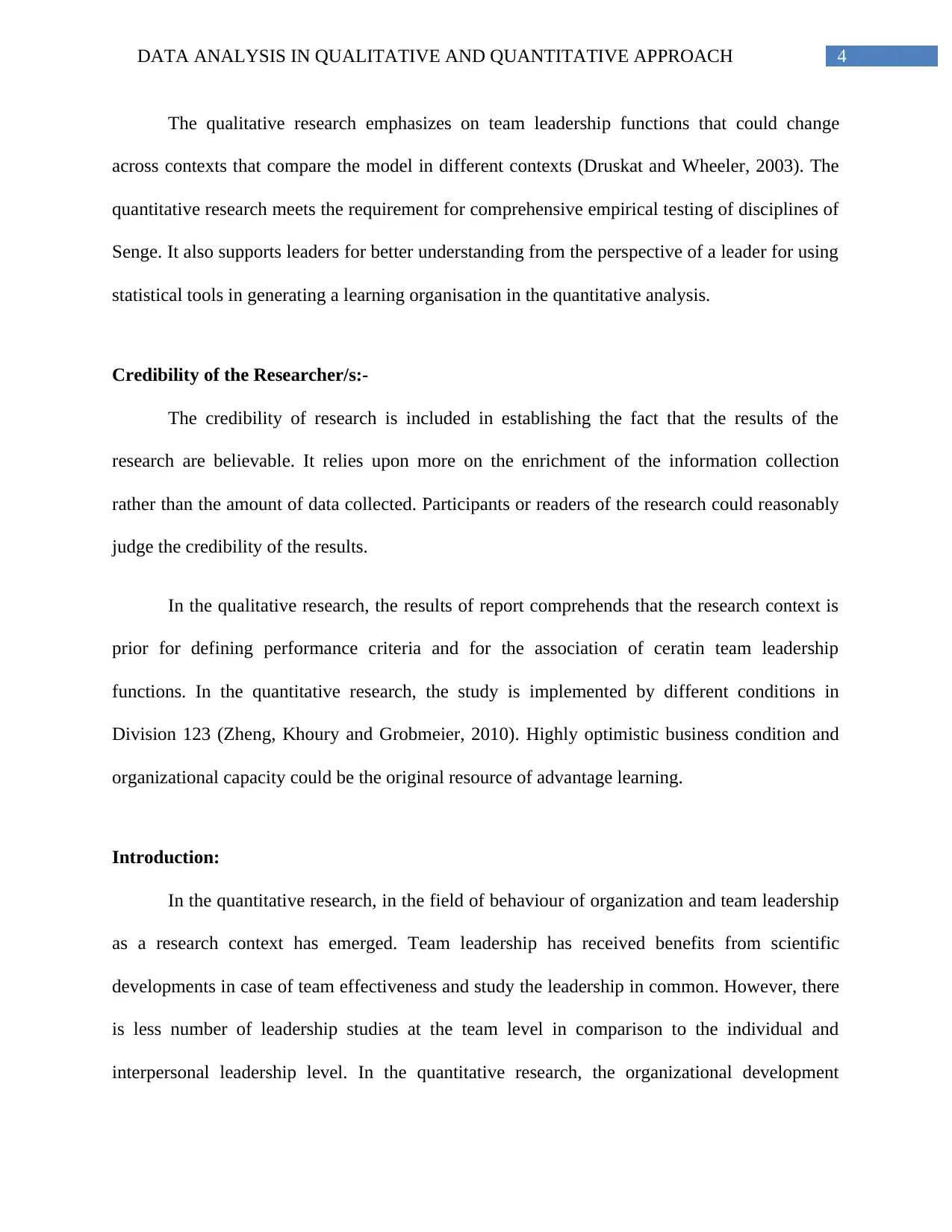
4DATA ANALYSIS IN QUALITATIVE AND QUANTITATIVE APPROACH
The qualitative research emphasizes on team leadership functions that could change
across contexts that compare the model in different contexts (Druskat and Wheeler, 2003). The
quantitative research meets the requirement for comprehensive empirical testing of disciplines of
Senge. It also supports leaders for better understanding from the perspective of a leader for using
statistical tools in generating a learning organisation in the quantitative analysis.
Credibility of the Researcher/s:-
The credibility of research is included in establishing the fact that the results of the
research are believable. It relies upon more on the enrichment of the information collection
rather than the amount of data collected. Participants or readers of the research could reasonably
judge the credibility of the results.
In the qualitative research, the results of report comprehends that the research context is
prior for defining performance criteria and for the association of ceratin team leadership
functions. In the quantitative research, the study is implemented by different conditions in
Division 123 (Zheng, Khoury and Grobmeier, 2010). Highly optimistic business condition and
organizational capacity could be the original resource of advantage learning.
Introduction:
In the quantitative research, in the field of behaviour of organization and team leadership
as a research context has emerged. Team leadership has received benefits from scientific
developments in case of team effectiveness and study the leadership in common. However, there
is less number of leadership studies at the team level in comparison to the individual and
interpersonal leadership level. In the quantitative research, the organizational development
The qualitative research emphasizes on team leadership functions that could change
across contexts that compare the model in different contexts (Druskat and Wheeler, 2003). The
quantitative research meets the requirement for comprehensive empirical testing of disciplines of
Senge. It also supports leaders for better understanding from the perspective of a leader for using
statistical tools in generating a learning organisation in the quantitative analysis.
Credibility of the Researcher/s:-
The credibility of research is included in establishing the fact that the results of the
research are believable. It relies upon more on the enrichment of the information collection
rather than the amount of data collected. Participants or readers of the research could reasonably
judge the credibility of the results.
In the qualitative research, the results of report comprehends that the research context is
prior for defining performance criteria and for the association of ceratin team leadership
functions. In the quantitative research, the study is implemented by different conditions in
Division 123 (Zheng, Khoury and Grobmeier, 2010). Highly optimistic business condition and
organizational capacity could be the original resource of advantage learning.
Introduction:
In the quantitative research, in the field of behaviour of organization and team leadership
as a research context has emerged. Team leadership has received benefits from scientific
developments in case of team effectiveness and study the leadership in common. However, there
is less number of leadership studies at the team level in comparison to the individual and
interpersonal leadership level. In the quantitative research, the organizational development
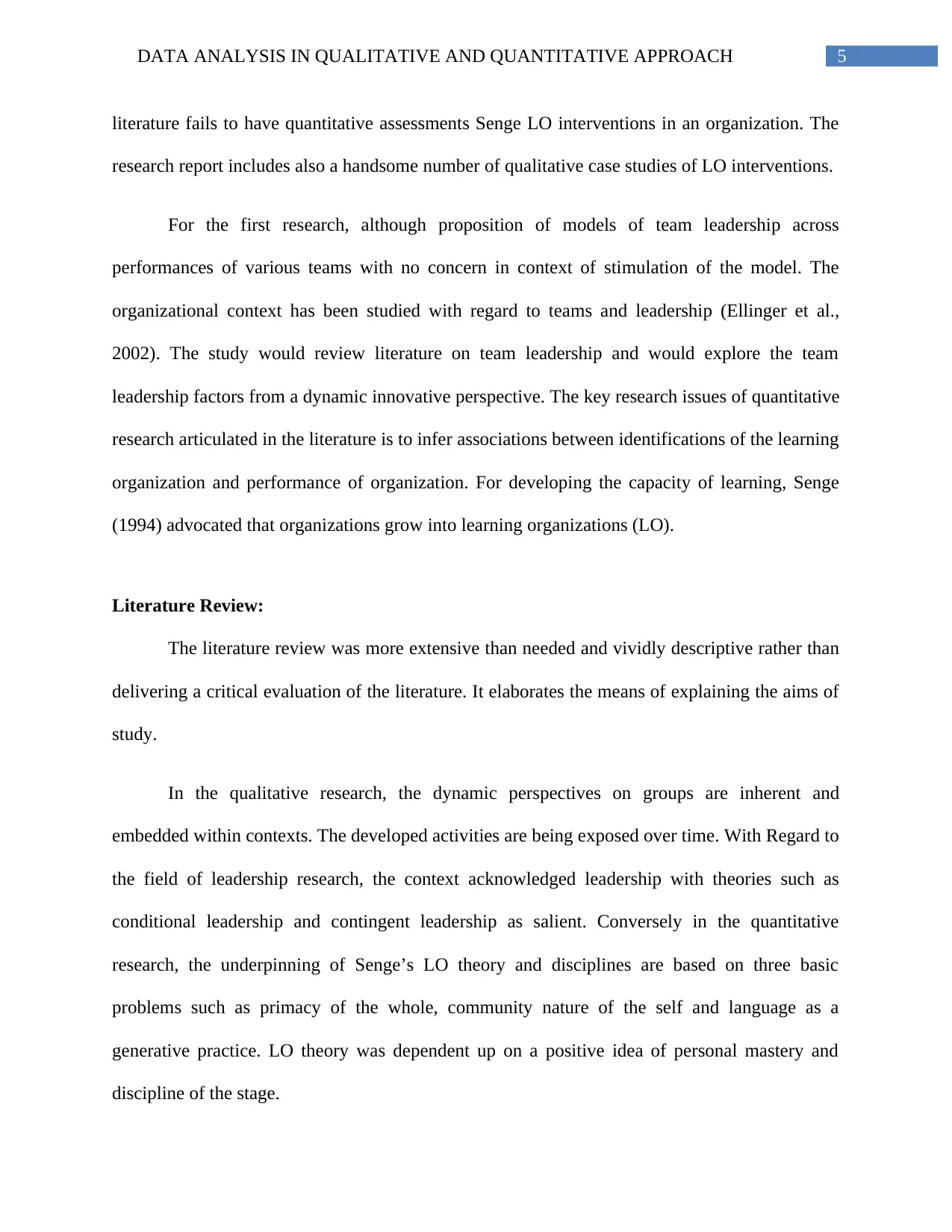
5DATA ANALYSIS IN QUALITATIVE AND QUANTITATIVE APPROACH
literature fails to have quantitative assessments Senge LO interventions in an organization. The
research report includes also a handsome number of qualitative case studies of LO interventions.
For the first research, although proposition of models of team leadership across
performances of various teams with no concern in context of stimulation of the model. The
organizational context has been studied with regard to teams and leadership (Ellinger et al.,
2002). The study would review literature on team leadership and would explore the team
leadership factors from a dynamic innovative perspective. The key research issues of quantitative
research articulated in the literature is to infer associations between identifications of the learning
organization and performance of organization. For developing the capacity of learning, Senge
(1994) advocated that organizations grow into learning organizations (LO).
Literature Review:
The literature review was more extensive than needed and vividly descriptive rather than
delivering a critical evaluation of the literature. It elaborates the means of explaining the aims of
study.
In the qualitative research, the dynamic perspectives on groups are inherent and
embedded within contexts. The developed activities are being exposed over time. With Regard to
the field of leadership research, the context acknowledged leadership with theories such as
conditional leadership and contingent leadership as salient. Conversely in the quantitative
research, the underpinning of Senge’s LO theory and disciplines are based on three basic
problems such as primacy of the whole, community nature of the self and language as a
generative practice. LO theory was dependent up on a positive idea of personal mastery and
discipline of the stage.
literature fails to have quantitative assessments Senge LO interventions in an organization. The
research report includes also a handsome number of qualitative case studies of LO interventions.
For the first research, although proposition of models of team leadership across
performances of various teams with no concern in context of stimulation of the model. The
organizational context has been studied with regard to teams and leadership (Ellinger et al.,
2002). The study would review literature on team leadership and would explore the team
leadership factors from a dynamic innovative perspective. The key research issues of quantitative
research articulated in the literature is to infer associations between identifications of the learning
organization and performance of organization. For developing the capacity of learning, Senge
(1994) advocated that organizations grow into learning organizations (LO).
Literature Review:
The literature review was more extensive than needed and vividly descriptive rather than
delivering a critical evaluation of the literature. It elaborates the means of explaining the aims of
study.
In the qualitative research, the dynamic perspectives on groups are inherent and
embedded within contexts. The developed activities are being exposed over time. With Regard to
the field of leadership research, the context acknowledged leadership with theories such as
conditional leadership and contingent leadership as salient. Conversely in the quantitative
research, the underpinning of Senge’s LO theory and disciplines are based on three basic
problems such as primacy of the whole, community nature of the self and language as a
generative practice. LO theory was dependent up on a positive idea of personal mastery and
discipline of the stage.
⊘ This is a preview!⊘
Do you want full access?
Subscribe today to unlock all pages.

Trusted by 1+ million students worldwide
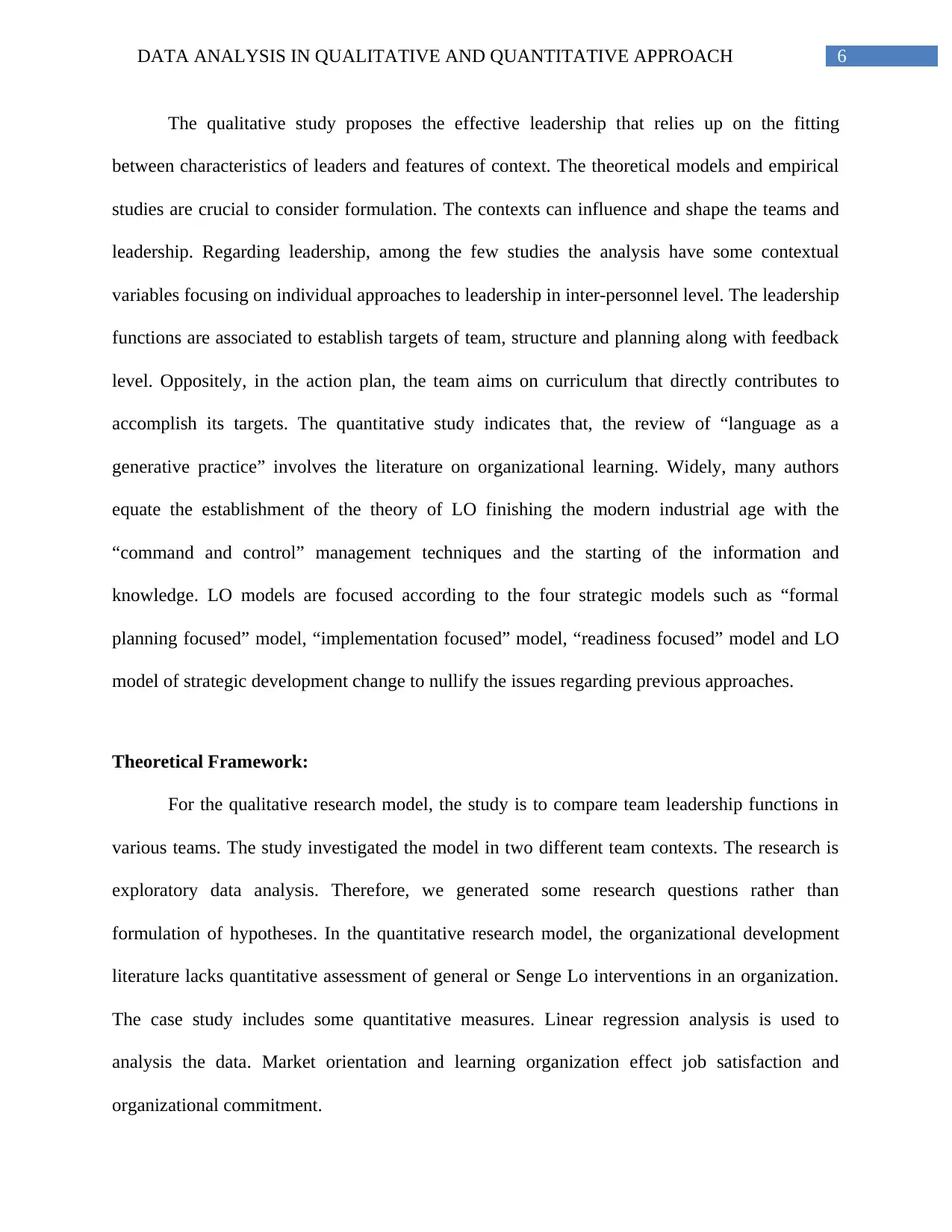
6DATA ANALYSIS IN QUALITATIVE AND QUANTITATIVE APPROACH
The qualitative study proposes the effective leadership that relies up on the fitting
between characteristics of leaders and features of context. The theoretical models and empirical
studies are crucial to consider formulation. The contexts can influence and shape the teams and
leadership. Regarding leadership, among the few studies the analysis have some contextual
variables focusing on individual approaches to leadership in inter-personnel level. The leadership
functions are associated to establish targets of team, structure and planning along with feedback
level. Oppositely, in the action plan, the team aims on curriculum that directly contributes to
accomplish its targets. The quantitative study indicates that, the review of “language as a
generative practice” involves the literature on organizational learning. Widely, many authors
equate the establishment of the theory of LO finishing the modern industrial age with the
“command and control” management techniques and the starting of the information and
knowledge. LO models are focused according to the four strategic models such as “formal
planning focused” model, “implementation focused” model, “readiness focused” model and LO
model of strategic development change to nullify the issues regarding previous approaches.
Theoretical Framework:
For the qualitative research model, the study is to compare team leadership functions in
various teams. The study investigated the model in two different team contexts. The research is
exploratory data analysis. Therefore, we generated some research questions rather than
formulation of hypotheses. In the quantitative research model, the organizational development
literature lacks quantitative assessment of general or Senge Lo interventions in an organization.
The case study includes some quantitative measures. Linear regression analysis is used to
analysis the data. Market orientation and learning organization effect job satisfaction and
organizational commitment.
The qualitative study proposes the effective leadership that relies up on the fitting
between characteristics of leaders and features of context. The theoretical models and empirical
studies are crucial to consider formulation. The contexts can influence and shape the teams and
leadership. Regarding leadership, among the few studies the analysis have some contextual
variables focusing on individual approaches to leadership in inter-personnel level. The leadership
functions are associated to establish targets of team, structure and planning along with feedback
level. Oppositely, in the action plan, the team aims on curriculum that directly contributes to
accomplish its targets. The quantitative study indicates that, the review of “language as a
generative practice” involves the literature on organizational learning. Widely, many authors
equate the establishment of the theory of LO finishing the modern industrial age with the
“command and control” management techniques and the starting of the information and
knowledge. LO models are focused according to the four strategic models such as “formal
planning focused” model, “implementation focused” model, “readiness focused” model and LO
model of strategic development change to nullify the issues regarding previous approaches.
Theoretical Framework:
For the qualitative research model, the study is to compare team leadership functions in
various teams. The study investigated the model in two different team contexts. The research is
exploratory data analysis. Therefore, we generated some research questions rather than
formulation of hypotheses. In the quantitative research model, the organizational development
literature lacks quantitative assessment of general or Senge Lo interventions in an organization.
The case study includes some quantitative measures. Linear regression analysis is used to
analysis the data. Market orientation and learning organization effect job satisfaction and
organizational commitment.
Paraphrase This Document
Need a fresh take? Get an instant paraphrase of this document with our AI Paraphraser
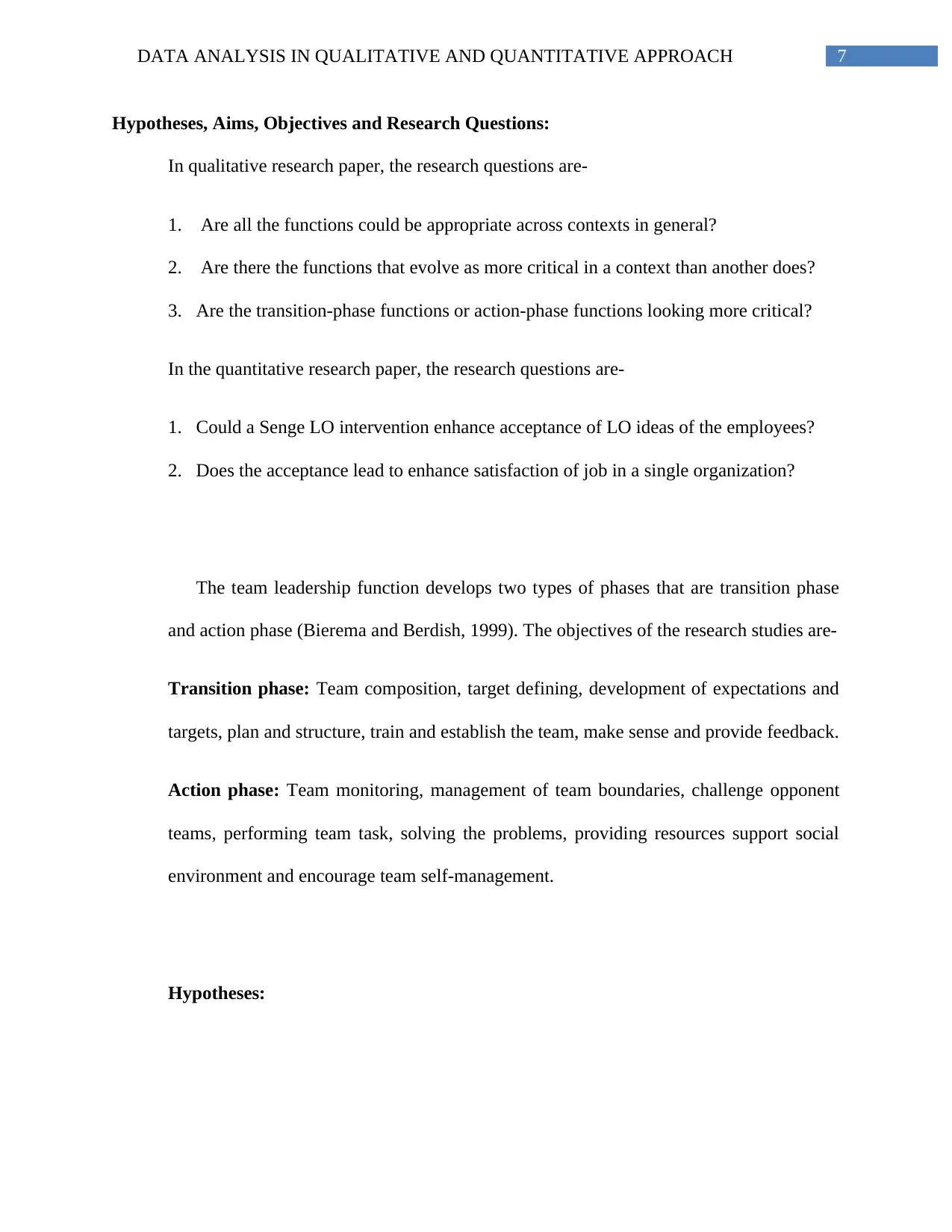
7DATA ANALYSIS IN QUALITATIVE AND QUANTITATIVE APPROACH
Hypotheses, Aims, Objectives and Research Questions:
In qualitative research paper, the research questions are-
1. Are all the functions could be appropriate across contexts in general?
2. Are there the functions that evolve as more critical in a context than another does?
3. Are the transition-phase functions or action-phase functions looking more critical?
In the quantitative research paper, the research questions are-
1. Could a Senge LO intervention enhance acceptance of LO ideas of the employees?
2. Does the acceptance lead to enhance satisfaction of job in a single organization?
The team leadership function develops two types of phases that are transition phase
and action phase (Bierema and Berdish, 1999). The objectives of the research studies are-
Transition phase: Team composition, target defining, development of expectations and
targets, plan and structure, train and establish the team, make sense and provide feedback.
Action phase: Team monitoring, management of team boundaries, challenge opponent
teams, performing team task, solving the problems, providing resources support social
environment and encourage team self-management.
Hypotheses:
Hypotheses, Aims, Objectives and Research Questions:
In qualitative research paper, the research questions are-
1. Are all the functions could be appropriate across contexts in general?
2. Are there the functions that evolve as more critical in a context than another does?
3. Are the transition-phase functions or action-phase functions looking more critical?
In the quantitative research paper, the research questions are-
1. Could a Senge LO intervention enhance acceptance of LO ideas of the employees?
2. Does the acceptance lead to enhance satisfaction of job in a single organization?
The team leadership function develops two types of phases that are transition phase
and action phase (Bierema and Berdish, 1999). The objectives of the research studies are-
Transition phase: Team composition, target defining, development of expectations and
targets, plan and structure, train and establish the team, make sense and provide feedback.
Action phase: Team monitoring, management of team boundaries, challenge opponent
teams, performing team task, solving the problems, providing resources support social
environment and encourage team self-management.
Hypotheses:
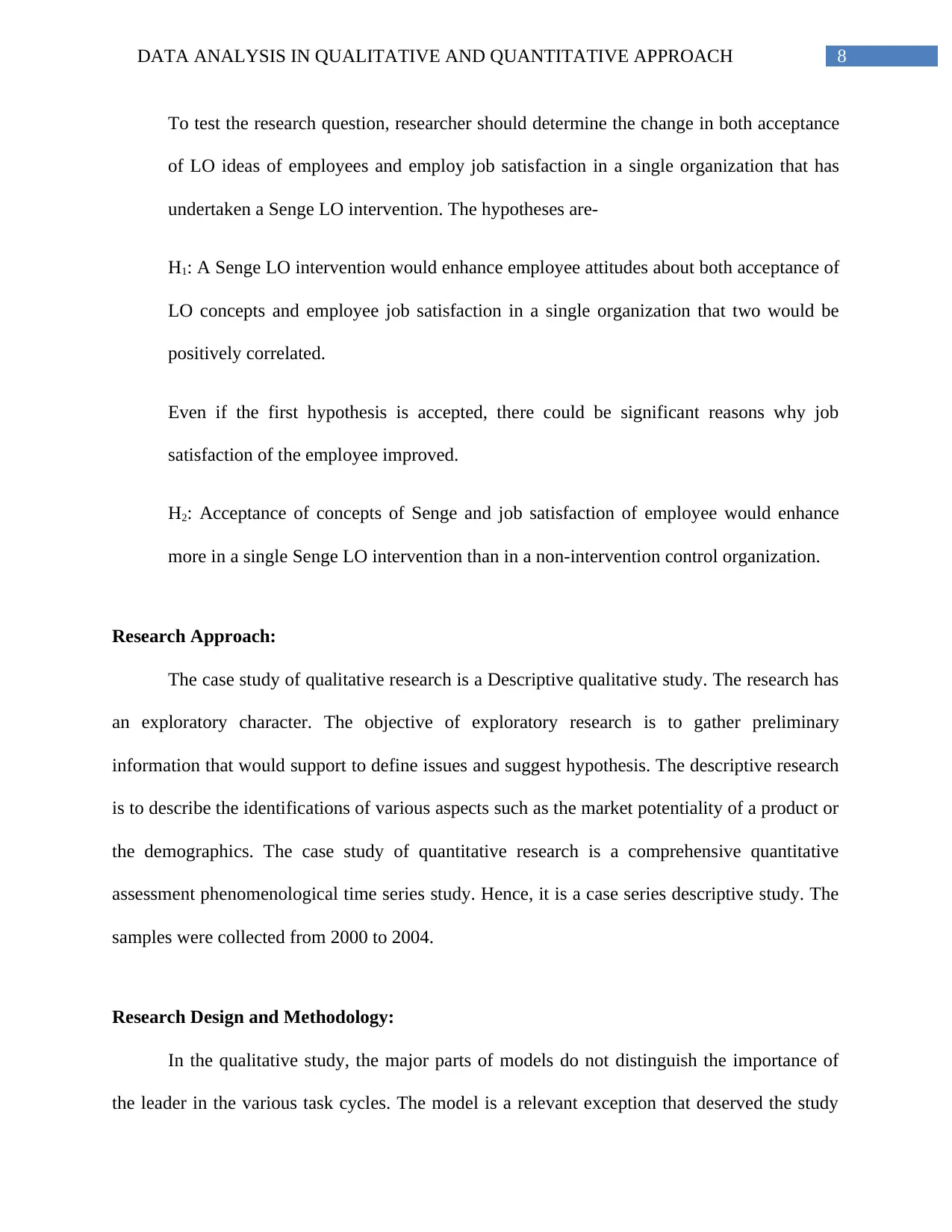
8DATA ANALYSIS IN QUALITATIVE AND QUANTITATIVE APPROACH
To test the research question, researcher should determine the change in both acceptance
of LO ideas of employees and employ job satisfaction in a single organization that has
undertaken a Senge LO intervention. The hypotheses are-
H1: A Senge LO intervention would enhance employee attitudes about both acceptance of
LO concepts and employee job satisfaction in a single organization that two would be
positively correlated.
Even if the first hypothesis is accepted, there could be significant reasons why job
satisfaction of the employee improved.
H2: Acceptance of concepts of Senge and job satisfaction of employee would enhance
more in a single Senge LO intervention than in a non-intervention control organization.
Research Approach:
The case study of qualitative research is a Descriptive qualitative study. The research has
an exploratory character. The objective of exploratory research is to gather preliminary
information that would support to define issues and suggest hypothesis. The descriptive research
is to describe the identifications of various aspects such as the market potentiality of a product or
the demographics. The case study of quantitative research is a comprehensive quantitative
assessment phenomenological time series study. Hence, it is a case series descriptive study. The
samples were collected from 2000 to 2004.
Research Design and Methodology:
In the qualitative study, the major parts of models do not distinguish the importance of
the leader in the various task cycles. The model is a relevant exception that deserved the study
To test the research question, researcher should determine the change in both acceptance
of LO ideas of employees and employ job satisfaction in a single organization that has
undertaken a Senge LO intervention. The hypotheses are-
H1: A Senge LO intervention would enhance employee attitudes about both acceptance of
LO concepts and employee job satisfaction in a single organization that two would be
positively correlated.
Even if the first hypothesis is accepted, there could be significant reasons why job
satisfaction of the employee improved.
H2: Acceptance of concepts of Senge and job satisfaction of employee would enhance
more in a single Senge LO intervention than in a non-intervention control organization.
Research Approach:
The case study of qualitative research is a Descriptive qualitative study. The research has
an exploratory character. The objective of exploratory research is to gather preliminary
information that would support to define issues and suggest hypothesis. The descriptive research
is to describe the identifications of various aspects such as the market potentiality of a product or
the demographics. The case study of quantitative research is a comprehensive quantitative
assessment phenomenological time series study. Hence, it is a case series descriptive study. The
samples were collected from 2000 to 2004.
Research Design and Methodology:
In the qualitative study, the major parts of models do not distinguish the importance of
the leader in the various task cycles. The model is a relevant exception that deserved the study
⊘ This is a preview!⊘
Do you want full access?
Subscribe today to unlock all pages.

Trusted by 1+ million students worldwide
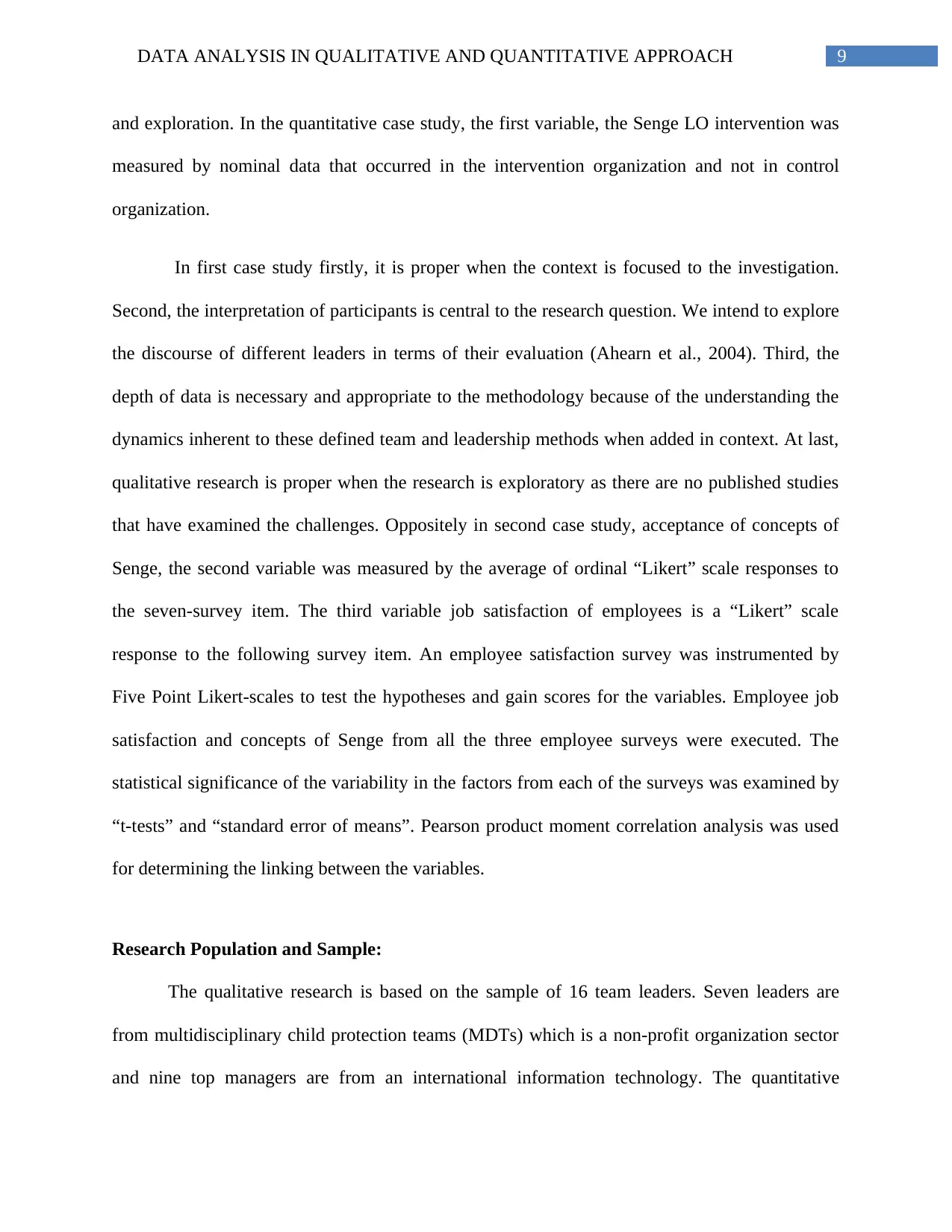
9DATA ANALYSIS IN QUALITATIVE AND QUANTITATIVE APPROACH
and exploration. In the quantitative case study, the first variable, the Senge LO intervention was
measured by nominal data that occurred in the intervention organization and not in control
organization.
In first case study firstly, it is proper when the context is focused to the investigation.
Second, the interpretation of participants is central to the research question. We intend to explore
the discourse of different leaders in terms of their evaluation (Ahearn et al., 2004). Third, the
depth of data is necessary and appropriate to the methodology because of the understanding the
dynamics inherent to these defined team and leadership methods when added in context. At last,
qualitative research is proper when the research is exploratory as there are no published studies
that have examined the challenges. Oppositely in second case study, acceptance of concepts of
Senge, the second variable was measured by the average of ordinal “Likert” scale responses to
the seven-survey item. The third variable job satisfaction of employees is a “Likert” scale
response to the following survey item. An employee satisfaction survey was instrumented by
Five Point Likert-scales to test the hypotheses and gain scores for the variables. Employee job
satisfaction and concepts of Senge from all the three employee surveys were executed. The
statistical significance of the variability in the factors from each of the surveys was examined by
“t-tests” and “standard error of means”. Pearson product moment correlation analysis was used
for determining the linking between the variables.
Research Population and Sample:
The qualitative research is based on the sample of 16 team leaders. Seven leaders are
from multidisciplinary child protection teams (MDTs) which is a non-profit organization sector
and nine top managers are from an international information technology. The quantitative
and exploration. In the quantitative case study, the first variable, the Senge LO intervention was
measured by nominal data that occurred in the intervention organization and not in control
organization.
In first case study firstly, it is proper when the context is focused to the investigation.
Second, the interpretation of participants is central to the research question. We intend to explore
the discourse of different leaders in terms of their evaluation (Ahearn et al., 2004). Third, the
depth of data is necessary and appropriate to the methodology because of the understanding the
dynamics inherent to these defined team and leadership methods when added in context. At last,
qualitative research is proper when the research is exploratory as there are no published studies
that have examined the challenges. Oppositely in second case study, acceptance of concepts of
Senge, the second variable was measured by the average of ordinal “Likert” scale responses to
the seven-survey item. The third variable job satisfaction of employees is a “Likert” scale
response to the following survey item. An employee satisfaction survey was instrumented by
Five Point Likert-scales to test the hypotheses and gain scores for the variables. Employee job
satisfaction and concepts of Senge from all the three employee surveys were executed. The
statistical significance of the variability in the factors from each of the surveys was examined by
“t-tests” and “standard error of means”. Pearson product moment correlation analysis was used
for determining the linking between the variables.
Research Population and Sample:
The qualitative research is based on the sample of 16 team leaders. Seven leaders are
from multidisciplinary child protection teams (MDTs) which is a non-profit organization sector
and nine top managers are from an international information technology. The quantitative
Paraphrase This Document
Need a fresh take? Get an instant paraphrase of this document with our AI Paraphraser
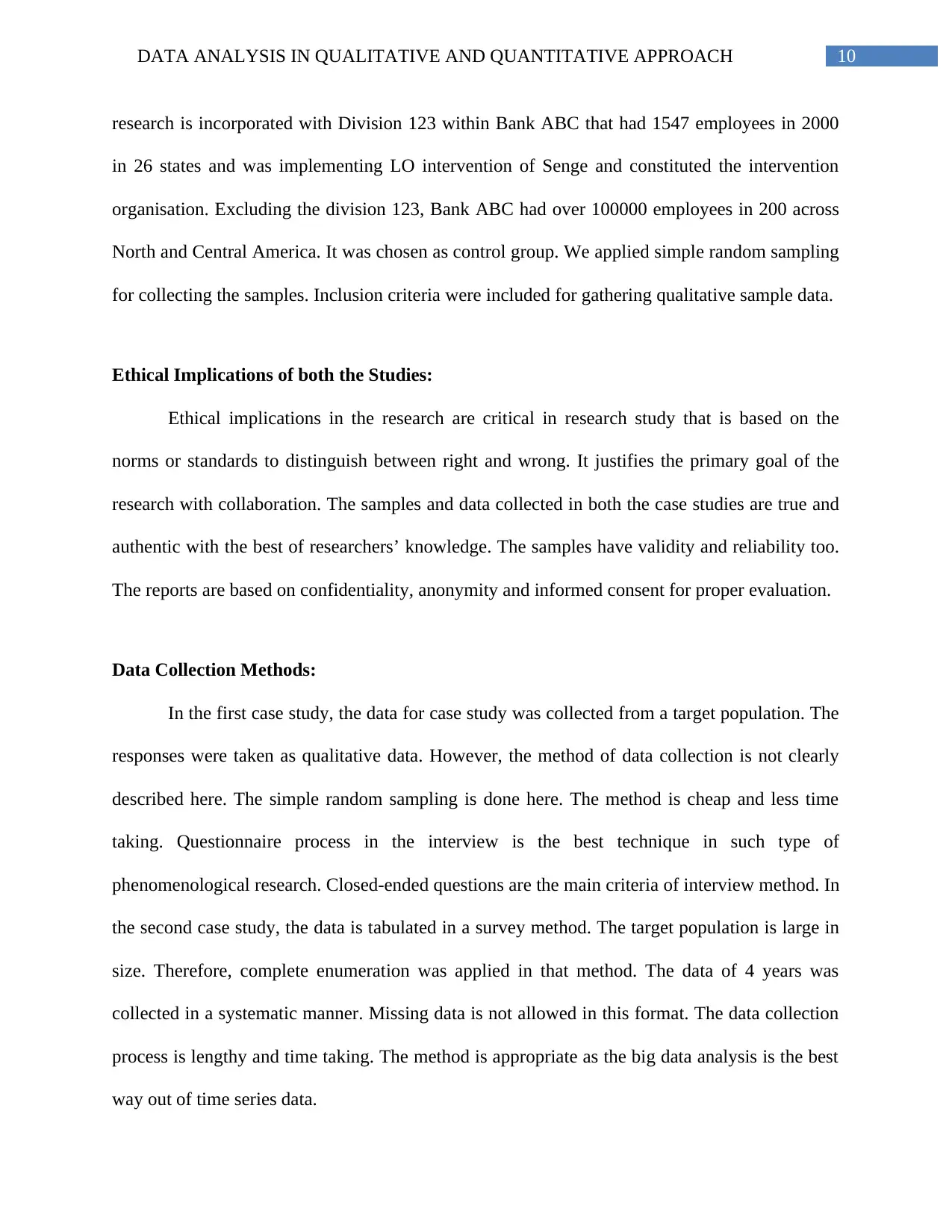
10DATA ANALYSIS IN QUALITATIVE AND QUANTITATIVE APPROACH
research is incorporated with Division 123 within Bank ABC that had 1547 employees in 2000
in 26 states and was implementing LO intervention of Senge and constituted the intervention
organisation. Excluding the division 123, Bank ABC had over 100000 employees in 200 across
North and Central America. It was chosen as control group. We applied simple random sampling
for collecting the samples. Inclusion criteria were included for gathering qualitative sample data.
Ethical Implications of both the Studies:
Ethical implications in the research are critical in research study that is based on the
norms or standards to distinguish between right and wrong. It justifies the primary goal of the
research with collaboration. The samples and data collected in both the case studies are true and
authentic with the best of researchers’ knowledge. The samples have validity and reliability too.
The reports are based on confidentiality, anonymity and informed consent for proper evaluation.
Data Collection Methods:
In the first case study, the data for case study was collected from a target population. The
responses were taken as qualitative data. However, the method of data collection is not clearly
described here. The simple random sampling is done here. The method is cheap and less time
taking. Questionnaire process in the interview is the best technique in such type of
phenomenological research. Closed-ended questions are the main criteria of interview method. In
the second case study, the data is tabulated in a survey method. The target population is large in
size. Therefore, complete enumeration was applied in that method. The data of 4 years was
collected in a systematic manner. Missing data is not allowed in this format. The data collection
process is lengthy and time taking. The method is appropriate as the big data analysis is the best
way out of time series data.
research is incorporated with Division 123 within Bank ABC that had 1547 employees in 2000
in 26 states and was implementing LO intervention of Senge and constituted the intervention
organisation. Excluding the division 123, Bank ABC had over 100000 employees in 200 across
North and Central America. It was chosen as control group. We applied simple random sampling
for collecting the samples. Inclusion criteria were included for gathering qualitative sample data.
Ethical Implications of both the Studies:
Ethical implications in the research are critical in research study that is based on the
norms or standards to distinguish between right and wrong. It justifies the primary goal of the
research with collaboration. The samples and data collected in both the case studies are true and
authentic with the best of researchers’ knowledge. The samples have validity and reliability too.
The reports are based on confidentiality, anonymity and informed consent for proper evaluation.
Data Collection Methods:
In the first case study, the data for case study was collected from a target population. The
responses were taken as qualitative data. However, the method of data collection is not clearly
described here. The simple random sampling is done here. The method is cheap and less time
taking. Questionnaire process in the interview is the best technique in such type of
phenomenological research. Closed-ended questions are the main criteria of interview method. In
the second case study, the data is tabulated in a survey method. The target population is large in
size. Therefore, complete enumeration was applied in that method. The data of 4 years was
collected in a systematic manner. Missing data is not allowed in this format. The data collection
process is lengthy and time taking. The method is appropriate as the big data analysis is the best
way out of time series data.
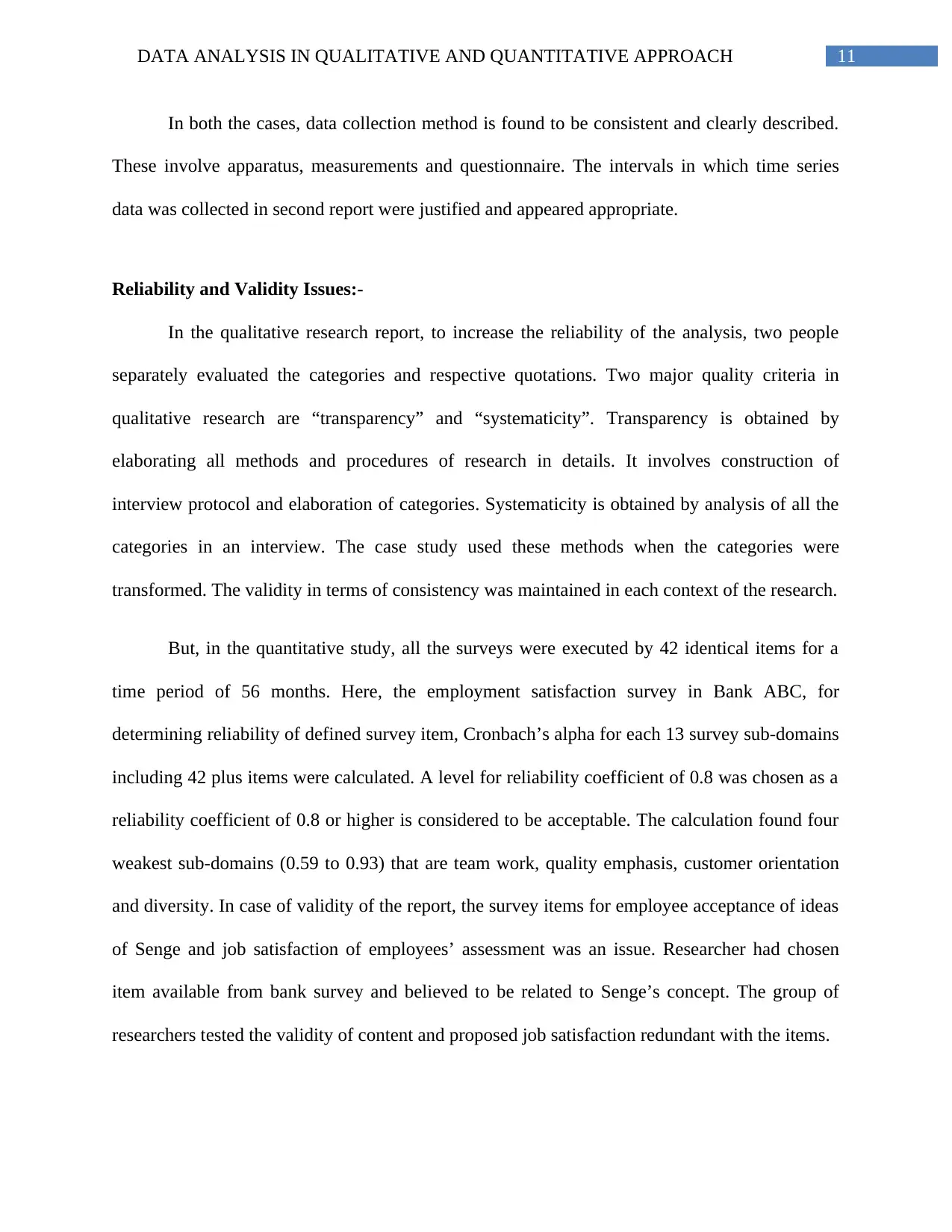
11DATA ANALYSIS IN QUALITATIVE AND QUANTITATIVE APPROACH
In both the cases, data collection method is found to be consistent and clearly described.
These involve apparatus, measurements and questionnaire. The intervals in which time series
data was collected in second report were justified and appeared appropriate.
Reliability and Validity Issues:-
In the qualitative research report, to increase the reliability of the analysis, two people
separately evaluated the categories and respective quotations. Two major quality criteria in
qualitative research are “transparency” and “systematicity”. Transparency is obtained by
elaborating all methods and procedures of research in details. It involves construction of
interview protocol and elaboration of categories. Systematicity is obtained by analysis of all the
categories in an interview. The case study used these methods when the categories were
transformed. The validity in terms of consistency was maintained in each context of the research.
But, in the quantitative study, all the surveys were executed by 42 identical items for a
time period of 56 months. Here, the employment satisfaction survey in Bank ABC, for
determining reliability of defined survey item, Cronbach’s alpha for each 13 survey sub-domains
including 42 plus items were calculated. A level for reliability coefficient of 0.8 was chosen as a
reliability coefficient of 0.8 or higher is considered to be acceptable. The calculation found four
weakest sub-domains (0.59 to 0.93) that are team work, quality emphasis, customer orientation
and diversity. In case of validity of the report, the survey items for employee acceptance of ideas
of Senge and job satisfaction of employees’ assessment was an issue. Researcher had chosen
item available from bank survey and believed to be related to Senge’s concept. The group of
researchers tested the validity of content and proposed job satisfaction redundant with the items.
In both the cases, data collection method is found to be consistent and clearly described.
These involve apparatus, measurements and questionnaire. The intervals in which time series
data was collected in second report were justified and appeared appropriate.
Reliability and Validity Issues:-
In the qualitative research report, to increase the reliability of the analysis, two people
separately evaluated the categories and respective quotations. Two major quality criteria in
qualitative research are “transparency” and “systematicity”. Transparency is obtained by
elaborating all methods and procedures of research in details. It involves construction of
interview protocol and elaboration of categories. Systematicity is obtained by analysis of all the
categories in an interview. The case study used these methods when the categories were
transformed. The validity in terms of consistency was maintained in each context of the research.
But, in the quantitative study, all the surveys were executed by 42 identical items for a
time period of 56 months. Here, the employment satisfaction survey in Bank ABC, for
determining reliability of defined survey item, Cronbach’s alpha for each 13 survey sub-domains
including 42 plus items were calculated. A level for reliability coefficient of 0.8 was chosen as a
reliability coefficient of 0.8 or higher is considered to be acceptable. The calculation found four
weakest sub-domains (0.59 to 0.93) that are team work, quality emphasis, customer orientation
and diversity. In case of validity of the report, the survey items for employee acceptance of ideas
of Senge and job satisfaction of employees’ assessment was an issue. Researcher had chosen
item available from bank survey and believed to be related to Senge’s concept. The group of
researchers tested the validity of content and proposed job satisfaction redundant with the items.
⊘ This is a preview!⊘
Do you want full access?
Subscribe today to unlock all pages.

Trusted by 1+ million students worldwide
1 out of 17
Your All-in-One AI-Powered Toolkit for Academic Success.
+13062052269
info@desklib.com
Available 24*7 on WhatsApp / Email
![[object Object]](/_next/static/media/star-bottom.7253800d.svg)
Unlock your academic potential
Copyright © 2020–2025 A2Z Services. All Rights Reserved. Developed and managed by ZUCOL.
